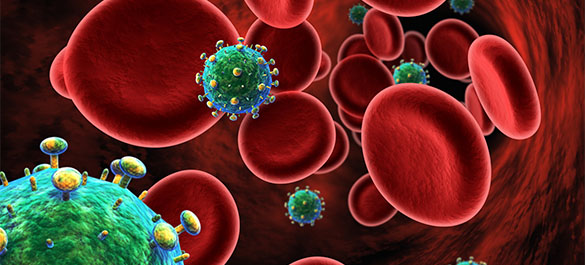
การจัดการภาวะแทรกซ้อนยาต้านรีโทรไวรัส ตอน 15
- โดย ภก.วิชญ์ภัทร ธรานนท์
- 19 พฤศจิกายน 2561
- Tweet

สาเหตุ
ภาวะพิษต่อตับเป็นไปได้ตั้งแต่มีค่าเอนไซม์ตับสูงกว่าปกติโดยไม่มีอาการ หรือมีเอนไซม์ตับสูงร่วมกับมีอาการของตับอักเสบ เช่น ปวดท้อง เบื่ออาหาร อ่อนเพลียหรือน้ำหนักลด ความเสี่ยงของการเกิดภาวะเป็นพิษต่อตับ คือ การติดเชื้อไวรัสตับอักเสบบีหรือไวรัสตับอักเสบซีร่วมด้วย การดื่มแอลกฮอล์มากหรือโรคพิษสุราเรื้อรังและมีการใช้ยาอื่นที่มีผลต่อตับร่วม ภาวะนี้เป็นสาเหตุที่ต้องมีการหยุดยาต้านรีโทรไวรัสบ่อย ภาวะสามารถเกิดขึ้นได้ตั้งแต่ 2 – 12 เดือน หลังเริ่มใช้ยา
กลไกการเกิดตับอักเสบยังไม่แน่ชัด มีการรายงาน 5 กลไกที่น่าจะเกี่ยวข้องกับการเกิดภาวะตับอักเสบ คือ 1. ความเป็นพิษโดยตรงต่อตับ 2. การเกิดภาวะภูมิไวเกิน (hypersensitivity reaction) 3. ความเป็นพิษต่อ mitochrondria 4. ความผิดปกติของกระบวนการเมทาบอลิซึม 5. ภาวะฟื้นตัวของภูมิคุ้มกัน (immune reconstitution syndrome) ในผู้ป่วยติดเชื้อไวรัสตับอักเสบบีและซี
ยากลุ่มเอ็นอาร์ทีไอ (NRTIs) ส่วนใหญ่มีผลพิษต่อตับ เกิดได้หลังได้รับยานานกลายเดือนหรือหลายปีทั้งจากซิโดวูดีน (zidovudine;AZT) ไดดาโนซีน (didanosine; ddI) และ สตาวูดีน (stavudine; d4T) ผู้ที่รับยาดีดาโนซีน (didanosine; ddI) นานจะสัมพันธ์กับการเกิดภาวะความดันเลือดปอร์ตัลสูง (portal hypertension) ที่ไม่ได้เกิดจากตับแข็ง และบางรายอาจพบเส้นเลือดโป่งพองในหลอดอาหาร (esophageal varices) ส่วน AZT, ddI, d4T ทำให้เกิดภาวะพิษต่อตับจากกลไกภาวะกรดแลกติกคั่งหรือจากการเป็นพิษต่อไมโทคอนเดรีย หรือ steatosis
ส่วนผู้ป่วยติดเชื้อเอชไอวีที่ติดเชื้อไวรัสตับอักเสบบีร่วมด้วยอาจมีภาวะพิษต่อตับได้ในช่วงแรกที่เริ่มยาต้านรีไทรไวรัส หรือเกิดจากการกำเริบ (flares) ของตับอักเสบอย่างรุนแรงเมื่อหยุดยาทีโนโฟเวียร์ (tenofovir disoproxil fumarate; TDF) ลามิวูดีน (lamivudine; 3TC) และ เอมตริไซตาบีน (emtricitabine) หรือเมื่อไวรัสตับอักเสบบีมีการดื้อยา
ยากลุ่มเอ็นเอ็นอาร์ทีไอ (NNRTIs) มีเนวิราปีน (nevirapine; NVP) ที่ทำให้เกิดภาวะพิษต่อตับมากที่สุด และยังทำให้มีผื่นหรือมีภาวะภูมิไวเกินร่วมด้วยได้บ่อย มักจะเกิดขึ้นภายใน 12 สัปดาห์แรกหลังเริ่มใช้ยาในผู้ที่ไม่เคยได้รับการรักษามาก่อน ความเสี่ยงจะเพิ่มขึ้นในผู้ป่วยหญิงที่มีระดับ CD-4 มากกว่า 250 cells/mm3 หรือผู้ป่วยเพศชายที่มีระดับ CD-4 มากกว่า 400 cells/mm3 ดังนั้น การเริ่มใช้ยาเนวิราปีนในขนาดยาครึ่งหนึ่ง 200 มิลลิกรัม/วัน ใน 14 วันแรกจะลดความเสี่ยงในการเกิดผื่น และลดการเกิดภาวะพิษต่อตับด้วย ถ้าผื่นนั้นสัมพันธ์กับการเกิดภาวะภูมิไวเกิน ไม่ควรใช้ยาเนวิราปีนในผู้ป่วยที่มีการทำงานของตับบกพร่องปานกลางถึงรุนแรง
ยากลุ่มโปรติเอส อินฮิบิเตอร์ (PIs) ทุกชนิดทำให้เกิดตับอักเสบหรือการทำงานของตับผิดปกติ ซึ่งเกิดหลังเริ่มยานานหลายสัปดาห์ถึงหลายเดือน มีความรุนแรงต่างกัน ส่วนใหญ่จะไม่มีอาการ บางรายอาจมีเบื่ออาหารหรือน้ำหนักลด ส่วนน้อยที่ทำให้ถึงแก่ชีวิต โดยยาที่มีพิษต่อตับมากที่สุด คือ ทิพล่านาเวียร์/ริโทรนาเวียร์ (tipranavir/ritonavir) แต่ยานี้ยังไม่มีในประเทศไทย ส่วน อินดินาเวียร์ (indinavir) และอะทาซานาเวียร์ (atazanavir) ทำให้บิลลิลูบิน (bilirubin) สูงหรือเหลือง เนื่องจากการเพิ่มขึ้นของบิลลิลูบิน ชนิด indirect โดยอะทาซานาเวียร์ (atazanavir) จะยับยั้ง UGT enzyme ซึ่งเป็นเอนไซม์ในขบวนการทำลายของบิลลิลูบินจึงทำให้เอนไซม์ทำงานลดลง ทำให้ indirect bilirubin เปลี่ยนไปเป็น direct bilirubin ลดลง จึงเกิดภาวะ indirect bilirubin สูงในเลือด
ยากลุ่ม INSTIs ชนิดใหม่ คือ โดลุทิกราเวียร์ (dolutegravir) สามารถทำให้เอนไซม์ตับสูงขึ้นในผู้ที่มีการติดเชื้อไวรัสตับอักเสบบีหรือไวรัสตับอักเสบซีร่วมด้วย
ส่วนยากลุ่ม CCR5 antagonist คือ มาลาวีลอค (maraviroc) มีรายงานทำให้เกิดภาวะพิษต่อตับ โดยมีผื่นหรือไม่มีผื่นร่วมได้
การป้องกัน
ตรวจการทำงานของตับ เช่น AST, ALT, TB ก่อนเริ่มการรักษาด้วยยาต้านรีโทร ไวรัสในผู้ป่วยติดเชื้อเอชไอวีทุกราย ถ้าได้รับยากลุ่ม NNRTIs โดยเฉพาะเนวิราปีน (nevirapine) และติดตามการทำงานของตับ (อย่างน้อย ALT) ที่เดือนที่ 3 และ 6 หลังใช้ยา หลังจากนั้นตรวจซ้ำทุก 6 เดือนหรือถี่กว่านั้นกรณีมีความเสี่ยง หากไม่ได้รับยากลุ่ม NNRTIs ให้ตรวจการทำงานของตับทุก 6 เดือน ตามแนวทางปฏิบัติของประเทศไทยปี พ.ศ. 2560 แนะนำให้ตรวจเฉพาะ ALT เมื่อพบว่าติดเชื้อเอชไอวี และตรวจซ้ำที่ 3 เดือนหลังเริ่มใช้ยา ถ้าผู้ป่วยมีการติดเชื้อไวรัสตับอักเสบร่วมด้วย ดื่มแอลกฮอล์หรือมีผลข้างเคียงจากยา หลังจากนั้นแล้วให้ตรวจตามข้อบ่งชี้
หากผู้ป่วยได้รับยาต้านรีโทรไวรัสอยู่ แล้วเกิดอาการไม่พึงประสงค์ดังกล่าว ข้างต้น หรือมีความผิดปกติอื่นๆ ควรรีบไปพบแพทย์โดยทันที เพื่อให้ได้รับการรักษาอย่างรวดเร็ว
การรักษา
หากตัดสาเหตุอื่นๆ ที่ทำให้เกิดภาวะตับอักเสบหรือมีเอนไซม์ตับสูงผิดปกติที่ไม่ได้ เกิดจากยาต้านรีโทรไวรัสได้แล้ว เช่น แอลกฮอล์ สมุนไพร ไวรัสตับอักเสบเรื้อรังที่อาจดื้อยาหรืออยู่ในระยะกำเริบ ภาวะไขมันแทรกในตับ และคาดว่าเกิดจากยาต้านรีโทรไวรัส ก็สามารถเปลี่ยนหรือหยุดยาที่เป็นสาเหตุได้ กรณีมีอาการของตับอักเสบ ไม่ว่าค่าเอนไซม์จะสูงเท่าใดก็ตาม แนะนำให้หยุดยาต้านรีโทรไวรัสที่เป็นสาเหตุ และเริ่มยาชนิดอื่นแทน หากยังไม่มีอาการและค่า ALT สูงน้อยกว่า 5 เท่าของค่าปกติ สามารถติดตามอาการและค่าเอนไชม์ตับต่อไปก่อนได้ แต่หากค่า ALT สูงมากกว่า 5 – 10 เท่าของค่าปกติและไม่มีอาการใดๆอาจทำได้ทั้งการติดตามอย่างใกล้ชิดหรือหยุดยา หากหยุดยาแล้วการอักเสบของตับดีขึ้น ให้เริ่มยาชนิดอื่นแทนยาที่สงสัยว่าเป็นสาเหตุ ถ้าผู้ป่วยมีโรคตับเรื้อรังและปรับเปลี่ยนยาต้านรีโทรไวรัสไม่ได้ ก็อาจให้ใช้ยาชนิดนั้นต่อแต่ปรับขนาดยาลดลงตามการทำงานของตับ หลักการหยุดยาต้านรีโทรไวรัสให้ทำเช่นเดียวกับการหยุดยากรณีมีผื่น
บรรณานุกรม:
- Department of disease control, Thailand National Guidelines on HIV/AIDS Treatment and Prevention 2017. availavle from http://www.thaiaidssociety.org/images/PDF/ hiv_thai_guideline _2560.pdf.
- Cohen DE, Mayer KH. Primary care issues for HIV-infected patients. Infect Dis Clin N Am 21 (2007): 49–70.
- วีรวัฒน์ มโนสุทธิ. Current management of complication of antiretroviral therapy. ใน: ชาญกิจ พุฒิเลอพงศ์, ณัฏฐดา อารีเปี่ยม, แสง อุษยาพร, บรรณาธิการ. Pharmacotherapy in infectious disease VII. กรุงเทพมหานคร. สำนักพิมพ์แห่งจุฬาลงกรณ์มหาวิทยาลัย. 2558, หน้า 198-201.
- Group TISS. Initiation of Antiretroviral Therapy in Early Asymptomatic HIV Infection. New England Journal of Medicine. 2015;373(9):795-807.
- Group TTAS. A Trial of Early Antiretrovirals and Isoniazid Preventive Therapy in Africa. New England Journal of Medicine. 2015;373(9):808-22.
- Ayoko R. Bossou SC, Karen K. O’Brien, Catherine A. Opere, Christopher J. Destache. Preventive HIV Vaccines: Progress and Challenges. US Pharmacist. 2015 OCTOBER 16, 2015:46-50.
- รัชนู เจริญพักตร์ และ ชาญกิจ พุฒิเลอพงศ์. Current update on HIV/AIDs treatment guideline in 2017. ใน: ชาญกิจ พุฒิเลอพงศ์, โชติรัตน์ นครานุรักษ์, และ แสง อุษยาพร, บรรณาธิการ. Pharmacotherapy in infectious disease IX. กรุงเทพมหานคร. สำนักพิมพ์แห่งจุฬาลงกรณ์มหาวิทยาลัย. 2560, หน้า 342-364.
- Wada N JL, Cohen M, French A, Phair J, Munoz A. Cause-specific life expectancies after 35 years of age for human immunodeficiency syndrome-infected and human immunodeficiency syndrome-negative individuals followed simultaneously in long-term cohort studies, 1984-2008. Am J Epidermol. 2013; 177: 116-125.
- Department of Health and Human Services. Guidelines for the Use of Antiretroviral Agents in Adults and Adolescents Living with HIV Available from: https://aidsinfo.nih.gov/guidelines.
- O'Brien ME, Clark RA, Besch CL, Myers L, Kissinger P. Patterns and correlates of discontinuation of the initial HAART regimen in an urban outpatient cohort. Journal of acquired immune deficiency syndromes (1999). 2003;34(4):407-14.
- Kiertiburanakul S, Luengroongroj P, Sungkanuparph S. Clinical characteristics of HIV-infected patients who survive after the diagnosis of HIV infection for more than 10 years in a resource-limited setting. Journal of the International Association of Physicians in AIDS Care (Chicago, Ill : 2002). 2012;11(6):361-5.
- Wiboonchutikul S, Sungkanuparph S, Kiertiburanakul S, Chailurkit LO, Charoenyingwattana A, Wangsomboonsiri W, et al. Vitamin D insufficiency and deficiency among HIV-1-infected patients in a tropical setting. Journal of the International Association of Physicians in AIDS Care (Chicago, Ill : 2002). 2012;11(5):305-10.
- Wilde JT, Lee CA, Collins P, Giangrande PL, Winter M, Shiach CR. Increased bleeding associated with protease inhibitor therapy in HIV-positive patients with bleeding disorders. British journal of haematology. 1999;107(3):556-9.
- European AIDS Clinical Society. EACS Guidelines version 8.1-October 2016. Available from http://www.eacsociety.org/files/guidelines_8.1-english.pdf.
- ศศิโสภิณ เกียรติบูรณกุล. การดูแลรักษาผู้ติดเชื้อเอชไอวีแบบผู้ป่วยนอก.กรุงเทพฯ : ภาควิชาอายุรศาสตร์ คณะแพทยศาตร์โรงพยาบาลรามาธิบดี มหาวิทยาลัยมหิดล, 2557
- Morse CG, Mican JM, Jones EC, Joe GO, Rick ME, Formentini E, et al. The incidence and natural history of osteonecrosis in HIV-infected adults. Clinical infectious diseases : an official publication of the Infectious Diseases Society of America. 2007;44(5):739-48.
- Woodward CL, Hall AM, Williams IG, Madge S, Copas A, Nair D, et al. Tenofovir-associated renal and bone toxicity. HIV medicine. 2009;10(8):482-7.
- Wang H, Lu X, Yang X, Xu N. The efficacy and safety of tenofovir alafenamide versus tenofovir disoproxil fumarate in antiretroviral regimens for HIV-1 therapy: Meta-analysis. Medicine. 2016;95(41):e5146.
- Redig AJ, Berliner N. Pathogenesis and clinical implications of HIV-related anemia in 2013. Hematology American Society of Hematology Education Program. 2013;2013:377-81.
- Assefa M, Abegaz WE, Shewamare A, Medhin G, Belay M. Prevalence and correlates of anemia among HIV infected patients on highly active anti-retroviral therapy at Zewditu Memorial Hospital, Ethiopia. BMC Hematology. 2015;15:6.
- de Gaetano Donati K, Cauda R, Iacoviello L. HIV Infection, Antiretroviral Therapy and Cardiovascular Risk. Mediterranean Journal of Hematology and Infectious Diseases. 2010;2(3):e2010034.
- Group TDS. Class of Antiretroviral Drugs and the Risk of Myocardial Infarction. New England Journal of Medicine. 2007;356(17):1723-35.
- Tsiodras S, Mantzoros C, Hammer S, Samore M. Effects of protease inhibitors on hyperglycemia, hyperlipidemia, and lipodystrophy: a 5-year cohort study. Archives of internal medicine. 2000;160(13):2050-6.
- วราภณ วงศ์ถาวราวัฒน์. Diagnosis and classification of Diabetes Mellitus. ใน: ธิติ สนับบุญ, บรรณาธิการ. แนวทางเวชปฏิบัติทางต่อมไร้ท่อ. กรุงเทพมหานคร.โรงพิมพ์แห่งจุฬาลงกรณ์มหาวิทยาลัย. 2560, หน้า 1-9.
- ชาญกิจ พุฒิเลอพงศ์. Clinical management for dyslipidemia in HIV-infected patients. ใน: ชาญกิจ พุฒิเลอพงศ์ และ ณัฏฐดา อารีเปี่ยม, บรรณาธิการ. Pharmacotherapy in infectious disease VI. กรุงเทพมหานคร. คอนเซ็พท์พริ้นท์. 2557, หน้า 198-201.
- Dube MP, Stein JH, Aberg JA, Fichtenbaum CJ, Gerber JG, Tashima KT, et al. Guidelines for the evaluation and management of dyslipidemia in human immunodeficiency virus (HIV)-infected adults receiving antiretroviral therapy: recommendations of the HIV Medical Association of the Infectious Disease Society of America and the Adult AIDS Clinical Trials Group. Clinical infectious diseases : an official publication of the Infectious Diseases Society of America. 2003;37(5):613-27.
- Hoffman RM, Currier JS. Management of antiretroviral treatment-related complications. Infectious disease clinics of North America. 2007;21(1):103-32, ix.
- Husain NEOS, Ahmed MH. Managing dyslipidemia in HIV/AIDS patients: challenges and solutions. HIV/AIDS (Auckland, NZ). 2015;7:1-10.
- Kiertiburanakul S, Sungkanuparph S, Charoenyingwattana A, Mahasirimongkol S, Sura T, Chantratita W. Risk factors for nevirapine-associated rash among HIV-infected patients with low CD4 cell counts in resource-limited settings. Current HIV research. 2008;6(1):65-9.
- Murphy RL. Defining the toxicity profile of nevirapine and other antiretroviral drugs. Journal of acquired immune deficiency syndromes (1999). 2003;34 Suppl 1:S15-20.
- Department of Health and Human Services. HIV and Lactic Acidosis. Available from: https://aidsinfo.nih.gov/understanding-hiv-aids/fact-sheets/22/68/hiv-and-lactic-acidosis.
- Grinspoon S, Carr A. Cardiovascular Risk and Body-Fat Abnormalities in HIV-Infected Adults. New England Journal of Medicine. 2005;352(1):48-62.
- Simpson D, Estanislao L, Evans S , McArthur J, Marcusd K, Truffa M et,al. HIV-associated neuromuscular weakness syndrome. AIDS (London, England). 2004;18(10):1403-12.
- Hall AM, Hendry BM, Nitsch D, Connolly JO. Tenofovir-associated kidney toxicity in HIV-infected patients: a review of the evidence. American journal of kidney diseases : the official journal of the National Kidney Foundation. 2011;57(5):773-80.
- Chaisiri K, Bowonwatanuwong C, Kasettratat N, Kiertiburanakul S. Incidence and risk factors for tenofovir-associated renal function decline among Thai HIV-infected patients with low-body weight. Current HIV research. 2010;8(7):504-9.
- Schwarzwald H, Gillespie S. Management of Antiretroviral-Associated Complications. Available from: https://bipai.org/sites/bipai/files/5-Mgt-assoc-complications.pdf
- ศศิโสภิณ เกียรติบูรณกุล. Practical management of complication-associated with ARVใน: นารัต เกษตรทัต, ชาญกิจ พุฒิเลอพงศ์ และ ณัฏฐดา อารีเปี่ยม, บรรณาธิการ. Pharmacotherapy in infectious disease VI. กรุงเทพมหานคร. คอนเซ็พท์พริ้นท์. 2554, หน้า 317-346.


